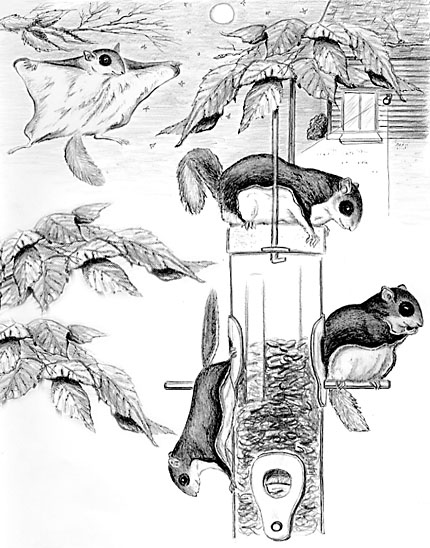
Dear Bird Folks,
A while ago I took your advice and put all of my bird feeders on a single pole. I attached a large baffle to keep off both raccoons and squirrels. Everything was working great until a few weeks ago when I noticed that my feeders were empty each morning. Then last night I switched on the backyard light and saw a bird flying off the feeder into the darkness. What kind of bird feeds at night and is it unusual?
– Richard, Marshfield, MA
Yes, it is, Richard,
It is unusual for a bird to eat at a feeder after dark. But it’s not as unusual as someone actually taking my advice. That’s a very rare event indeed. And the fact that my advice actually worked, at least for a little while, is even more amazing. I’m glad you took my advice. Most people stopped listening to me after I told them to support A.I.G. (you know, the Audubon Institute for Goldfinches). I thought it was a great way to help protect our beautiful yellow finches. But apparently there’s some problematic company also called A.I.G. Funny, this other A.I.G. company was never mentioned on my favorite source for information, CNN (the Chickadee News Network).
The list of active nighttime birds is fairly short. There are the owls, of course, but you won’t see an owl eating birdseed. They are strict followers of Atkins. If their food isn’t dripping in blood, they aren’t interested. Whip-poor-wills and nighthawks feed at night, but they too are meat eaters, which they get in the form of flying insects. Most other birds, especially our birdseed-loving birds, sleep at night. Hmm. I’m beginning to think you aren’t seeing a bird at all. You may be dealing with one of mankind’s greatest fears. It’s either Mothra, the giant moth that tried to eat Japan, or it’s something even more menacing. That’s right, a squirrel, a squirrel with wings. It doesn’t come any more sinister than that.
I’m betting you have flying squirrels coming to your feeder. Flying squirrels are far more common than most people think because, as you have found out, they like to feed well after dark. I have several insomniatic customers who regularly see these little critters on their feeders. A few have brought in amazing photos. Talk about cute. I think even the president of the Squirrel Haters Club would have to admit that these endearing creatures are hard not to like.
World-wide there are about forty different species of flying squirrels. North America has two species, which have the clever names of Northern Flying Squirrel and Southern Flying Squirrel. Here in eastern Massachusetts we have the slightly smaller southern variety. And small is the word for this squirrel. They are about the size of a baked potato, with a long flat tail and crazy big dark eyes. But it’s not their big eyes, flat tail or spud-shaped body that make this creature unusual; it’s the weird folds of skin that connect the front and back legs that sets this mammal apart. The folds of skin (called “patagium” for all of you crossword puzzle freaks out there) are what the flying squirrel uses to “fly” with, which it doesn’t actually do. Unlike birds, flying squirrels don’t flap their arms. To travel aloft they first must climb to a high location, size-up the situation by moving their head from side to side, check the wind by licking their index finger and holding it up, and then leaping into their air. Once airborne, the squirrels stretch out their legs and glide up to 150 feet towards their destination, using their flat tail to steer. As they cross the sky they look a bit like tiny human hang gliders, but without those nerdy helmets.
Flying squirrels sometimes find their way into our attics, which may or may not be a fun thing depending on how generous you happen to be. They will also use birdhouses, but typically nest in old tree cavities. Years ago, when I was more adventurous and flexible, I climbed up a tree to investigate a fresh hole that I thought contained a woodpecker. As I peered into the hole a giant non-woodpecker eye peered back at me. I was down the tree, across the yard and in the house with the doors locked before I realized I had seen my first flying squirrel.
When it comes to breeding, as with most mammals, it’s the female flying squirrel that does most of the work. The male only does what is required and then spends the rest of the time bragging about it to his friends. In the winter flying squirrels are much chummier. They often gather by the dozens in large cavities to share the warmth. When they get together, these cuddly creatures communicate with each other by using soft chirps, different scents and touching. Huh. Sounds like a personal ad that I once wrote, I mean read, I mean heard about.
I have no great advice on how to keep flying squirrels off your feeders, Richard. Daytime squirrels are enough of a challenge. You could take your feeders in at night; but if I were you, I’d just enjoy watching them. Watching flying squirrels could make for an exciting night. You should try it, at least until you get lucky with that personal ad.